Enhancing Patient Safety: Strategies and Challenges in Healthcare
VerifiedAdded on 2023/06/08
|26
|10146
|183
Report
AI Summary
This report provides a comprehensive analysis of patient safety in the health and social care sector, focusing on the critical role healthcare systems play in ensuring patient well-being. It identifies challenges and potential risks that can lead to patient harm, such as medication errors, healthcare-associated infections, and unsafe surgical procedures. The report also explores strategies and interventions aimed at minimizing these risks and improving overall patient safety, including the implementation of clear policies, strong leadership, data-driven improvements, skilled healthcare professionals, and effective patient involvement. Furthermore, the study incorporates a theoretical framework for change, outlining SMART objectives, communication plans, and project plans to facilitate the successful implementation of patient safety measures within healthcare settings. The ultimate goal is to promote a culture of safety, reduce costs associated with patient harm, and enhance the efficiency and trustworthiness of healthcare systems.
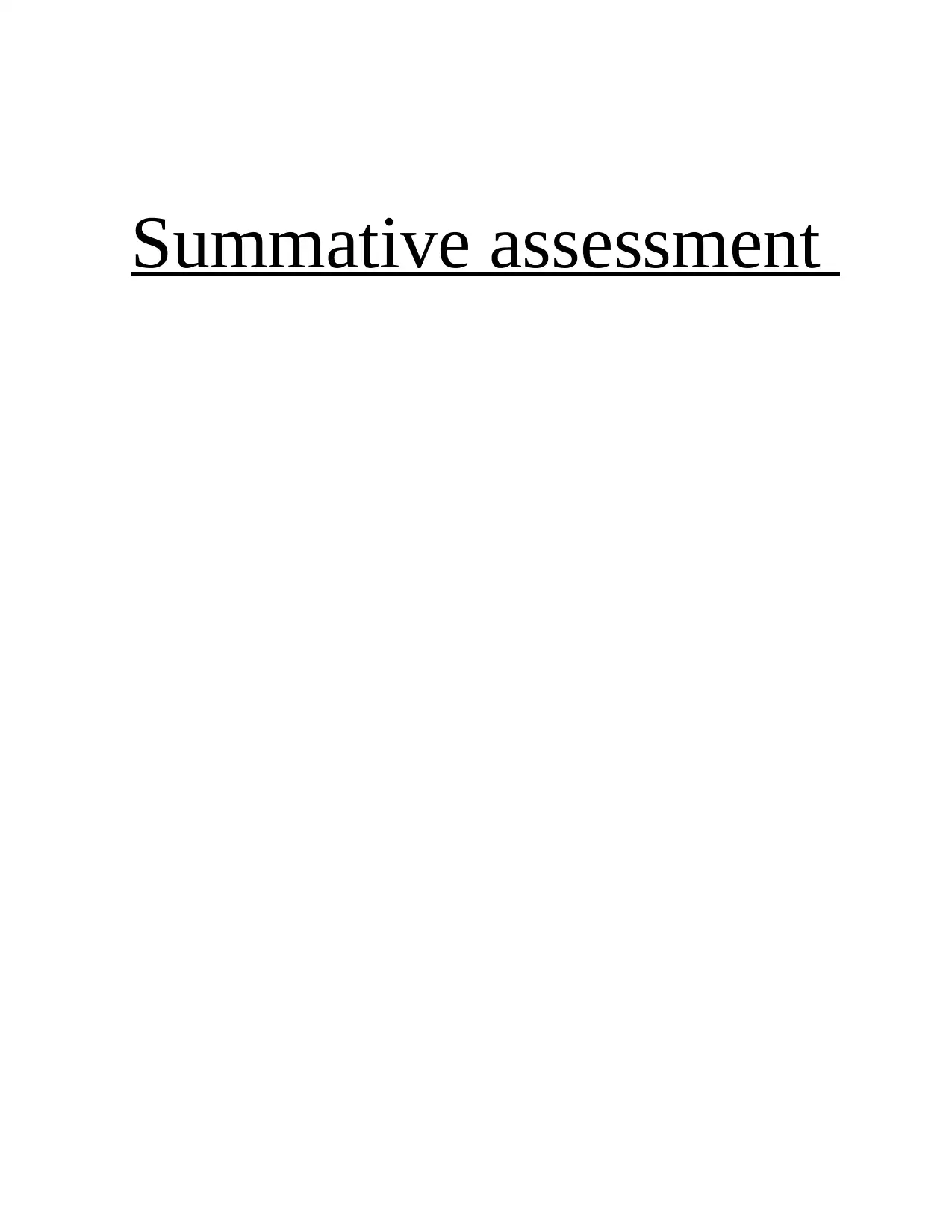
Summative assessment
Paraphrase This Document
Need a fresh take? Get an instant paraphrase of this document with our AI Paraphraser

Table of Contents
INTRODUCTION...........................................................................................................................1
AIM AND OBJECTIVE..................................................................................................................3
Aim.........................................................................................................................................3
Objective.................................................................................................................................3
LITERATURE REVIEW................................................................................................................3
Notion of patient safety in health and social care sector........................................................3
Causes and challenge during constructing patient safety in healthcare setting......................6
Ways and strategies that used to minimise the challenge during implementing patient safety in
healthcare setting....................................................................................................................8
THEORECTICAL FRAMEWORK FOR CHANGE....................................................................11
SMART OBJECTIVE..........................................................................................................11
Communication plan............................................................................................................11
Gantt chart............................................................................................................................14
PROJECT PLAN...........................................................................................................................15
The plan................................................................................................................................15
The budget............................................................................................................................16
Contingency plan..................................................................................................................16
Project plan...........................................................................................................................17
CONCLUSION..............................................................................................................................18
REFERENCES..............................................................................................................................19
INTRODUCTION...........................................................................................................................1
AIM AND OBJECTIVE..................................................................................................................3
Aim.........................................................................................................................................3
Objective.................................................................................................................................3
LITERATURE REVIEW................................................................................................................3
Notion of patient safety in health and social care sector........................................................3
Causes and challenge during constructing patient safety in healthcare setting......................6
Ways and strategies that used to minimise the challenge during implementing patient safety in
healthcare setting....................................................................................................................8
THEORECTICAL FRAMEWORK FOR CHANGE....................................................................11
SMART OBJECTIVE..........................................................................................................11
Communication plan............................................................................................................11
Gantt chart............................................................................................................................14
PROJECT PLAN...........................................................................................................................15
The plan................................................................................................................................15
The budget............................................................................................................................16
Contingency plan..................................................................................................................16
Project plan...........................................................................................................................17
CONCLUSION..............................................................................................................................18
REFERENCES..............................................................................................................................19
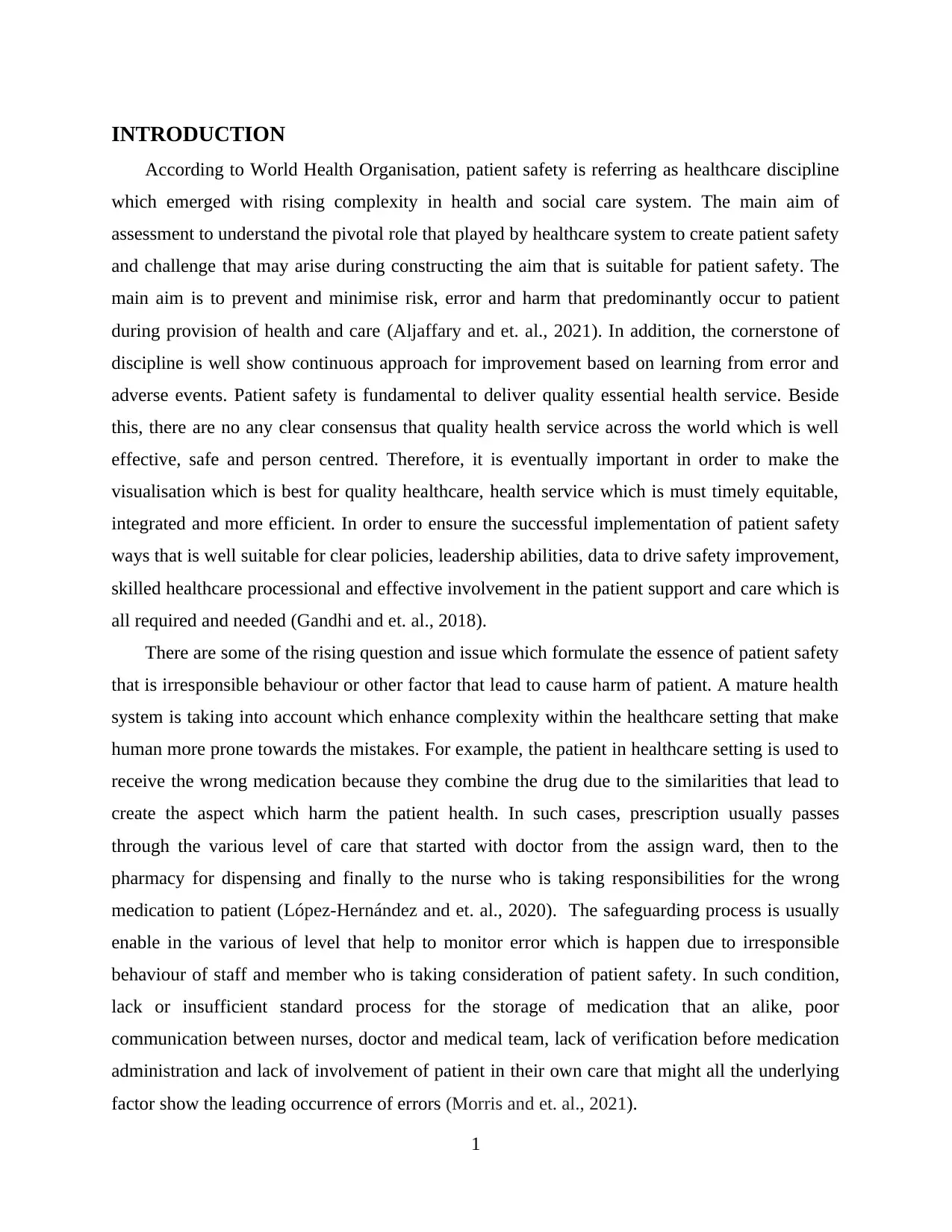
INTRODUCTION
According to World Health Organisation, patient safety is referring as healthcare discipline
which emerged with rising complexity in health and social care system. The main aim of
assessment to understand the pivotal role that played by healthcare system to create patient safety
and challenge that may arise during constructing the aim that is suitable for patient safety. The
main aim is to prevent and minimise risk, error and harm that predominantly occur to patient
during provision of health and care (Aljaffary and et. al., 2021). In addition, the cornerstone of
discipline is well show continuous approach for improvement based on learning from error and
adverse events. Patient safety is fundamental to deliver quality essential health service. Beside
this, there are no any clear consensus that quality health service across the world which is well
effective, safe and person centred. Therefore, it is eventually important in order to make the
visualisation which is best for quality healthcare, health service which is must timely equitable,
integrated and more efficient. In order to ensure the successful implementation of patient safety
ways that is well suitable for clear policies, leadership abilities, data to drive safety improvement,
skilled healthcare processional and effective involvement in the patient support and care which is
all required and needed (Gandhi and et. al., 2018).
There are some of the rising question and issue which formulate the essence of patient safety
that is irresponsible behaviour or other factor that lead to cause harm of patient. A mature health
system is taking into account which enhance complexity within the healthcare setting that make
human more prone towards the mistakes. For example, the patient in healthcare setting is used to
receive the wrong medication because they combine the drug due to the similarities that lead to
create the aspect which harm the patient health. In such cases, prescription usually passes
through the various level of care that started with doctor from the assign ward, then to the
pharmacy for dispensing and finally to the nurse who is taking responsibilities for the wrong
medication to patient (López-Hernández and et. al., 2020). The safeguarding process is usually
enable in the various of level that help to monitor error which is happen due to irresponsible
behaviour of staff and member who is taking consideration of patient safety. In such condition,
lack or insufficient standard process for the storage of medication that an alike, poor
communication between nurses, doctor and medical team, lack of verification before medication
administration and lack of involvement of patient in their own care that might all the underlying
factor show the leading occurrence of errors (Morris and et. al., 2021).
1
According to World Health Organisation, patient safety is referring as healthcare discipline
which emerged with rising complexity in health and social care system. The main aim of
assessment to understand the pivotal role that played by healthcare system to create patient safety
and challenge that may arise during constructing the aim that is suitable for patient safety. The
main aim is to prevent and minimise risk, error and harm that predominantly occur to patient
during provision of health and care (Aljaffary and et. al., 2021). In addition, the cornerstone of
discipline is well show continuous approach for improvement based on learning from error and
adverse events. Patient safety is fundamental to deliver quality essential health service. Beside
this, there are no any clear consensus that quality health service across the world which is well
effective, safe and person centred. Therefore, it is eventually important in order to make the
visualisation which is best for quality healthcare, health service which is must timely equitable,
integrated and more efficient. In order to ensure the successful implementation of patient safety
ways that is well suitable for clear policies, leadership abilities, data to drive safety improvement,
skilled healthcare processional and effective involvement in the patient support and care which is
all required and needed (Gandhi and et. al., 2018).
There are some of the rising question and issue which formulate the essence of patient safety
that is irresponsible behaviour or other factor that lead to cause harm of patient. A mature health
system is taking into account which enhance complexity within the healthcare setting that make
human more prone towards the mistakes. For example, the patient in healthcare setting is used to
receive the wrong medication because they combine the drug due to the similarities that lead to
create the aspect which harm the patient health. In such cases, prescription usually passes
through the various level of care that started with doctor from the assign ward, then to the
pharmacy for dispensing and finally to the nurse who is taking responsibilities for the wrong
medication to patient (López-Hernández and et. al., 2020). The safeguarding process is usually
enable in the various of level that help to monitor error which is happen due to irresponsible
behaviour of staff and member who is taking consideration of patient safety. In such condition,
lack or insufficient standard process for the storage of medication that an alike, poor
communication between nurses, doctor and medical team, lack of verification before medication
administration and lack of involvement of patient in their own care that might all the underlying
factor show the leading occurrence of errors (Morris and et. al., 2021).
1
⊘ This is a preview!⊘
Do you want full access?
Subscribe today to unlock all pages.

Trusted by 1+ million students worldwide
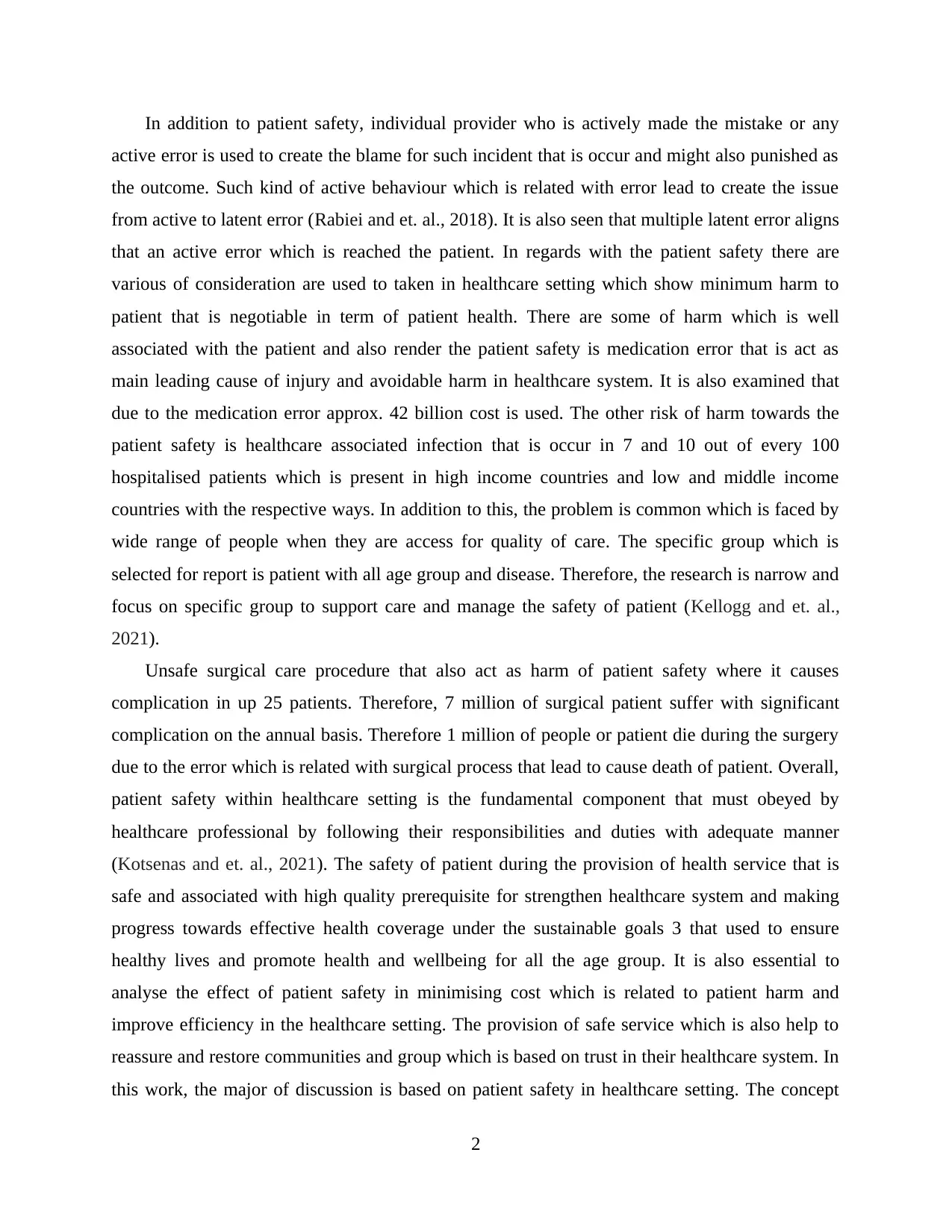
In addition to patient safety, individual provider who is actively made the mistake or any
active error is used to create the blame for such incident that is occur and might also punished as
the outcome. Such kind of active behaviour which is related with error lead to create the issue
from active to latent error (Rabiei and et. al., 2018). It is also seen that multiple latent error aligns
that an active error which is reached the patient. In regards with the patient safety there are
various of consideration are used to taken in healthcare setting which show minimum harm to
patient that is negotiable in term of patient health. There are some of harm which is well
associated with the patient and also render the patient safety is medication error that is act as
main leading cause of injury and avoidable harm in healthcare system. It is also examined that
due to the medication error approx. 42 billion cost is used. The other risk of harm towards the
patient safety is healthcare associated infection that is occur in 7 and 10 out of every 100
hospitalised patients which is present in high income countries and low and middle income
countries with the respective ways. In addition to this, the problem is common which is faced by
wide range of people when they are access for quality of care. The specific group which is
selected for report is patient with all age group and disease. Therefore, the research is narrow and
focus on specific group to support care and manage the safety of patient (Kellogg and et. al.,
2021).
Unsafe surgical care procedure that also act as harm of patient safety where it causes
complication in up 25 patients. Therefore, 7 million of surgical patient suffer with significant
complication on the annual basis. Therefore 1 million of people or patient die during the surgery
due to the error which is related with surgical process that lead to cause death of patient. Overall,
patient safety within healthcare setting is the fundamental component that must obeyed by
healthcare professional by following their responsibilities and duties with adequate manner
(Kotsenas and et. al., 2021). The safety of patient during the provision of health service that is
safe and associated with high quality prerequisite for strengthen healthcare system and making
progress towards effective health coverage under the sustainable goals 3 that used to ensure
healthy lives and promote health and wellbeing for all the age group. It is also essential to
analyse the effect of patient safety in minimising cost which is related to patient harm and
improve efficiency in the healthcare setting. The provision of safe service which is also help to
reassure and restore communities and group which is based on trust in their healthcare system. In
this work, the major of discussion is based on patient safety in healthcare setting. The concept
2
active error is used to create the blame for such incident that is occur and might also punished as
the outcome. Such kind of active behaviour which is related with error lead to create the issue
from active to latent error (Rabiei and et. al., 2018). It is also seen that multiple latent error aligns
that an active error which is reached the patient. In regards with the patient safety there are
various of consideration are used to taken in healthcare setting which show minimum harm to
patient that is negotiable in term of patient health. There are some of harm which is well
associated with the patient and also render the patient safety is medication error that is act as
main leading cause of injury and avoidable harm in healthcare system. It is also examined that
due to the medication error approx. 42 billion cost is used. The other risk of harm towards the
patient safety is healthcare associated infection that is occur in 7 and 10 out of every 100
hospitalised patients which is present in high income countries and low and middle income
countries with the respective ways. In addition to this, the problem is common which is faced by
wide range of people when they are access for quality of care. The specific group which is
selected for report is patient with all age group and disease. Therefore, the research is narrow and
focus on specific group to support care and manage the safety of patient (Kellogg and et. al.,
2021).
Unsafe surgical care procedure that also act as harm of patient safety where it causes
complication in up 25 patients. Therefore, 7 million of surgical patient suffer with significant
complication on the annual basis. Therefore 1 million of people or patient die during the surgery
due to the error which is related with surgical process that lead to cause death of patient. Overall,
patient safety within healthcare setting is the fundamental component that must obeyed by
healthcare professional by following their responsibilities and duties with adequate manner
(Kotsenas and et. al., 2021). The safety of patient during the provision of health service that is
safe and associated with high quality prerequisite for strengthen healthcare system and making
progress towards effective health coverage under the sustainable goals 3 that used to ensure
healthy lives and promote health and wellbeing for all the age group. It is also essential to
analyse the effect of patient safety in minimising cost which is related to patient harm and
improve efficiency in the healthcare setting. The provision of safe service which is also help to
reassure and restore communities and group which is based on trust in their healthcare system. In
this work, the major of discussion is based on patient safety in healthcare setting. The concept
2
Paraphrase This Document
Need a fresh take? Get an instant paraphrase of this document with our AI Paraphraser
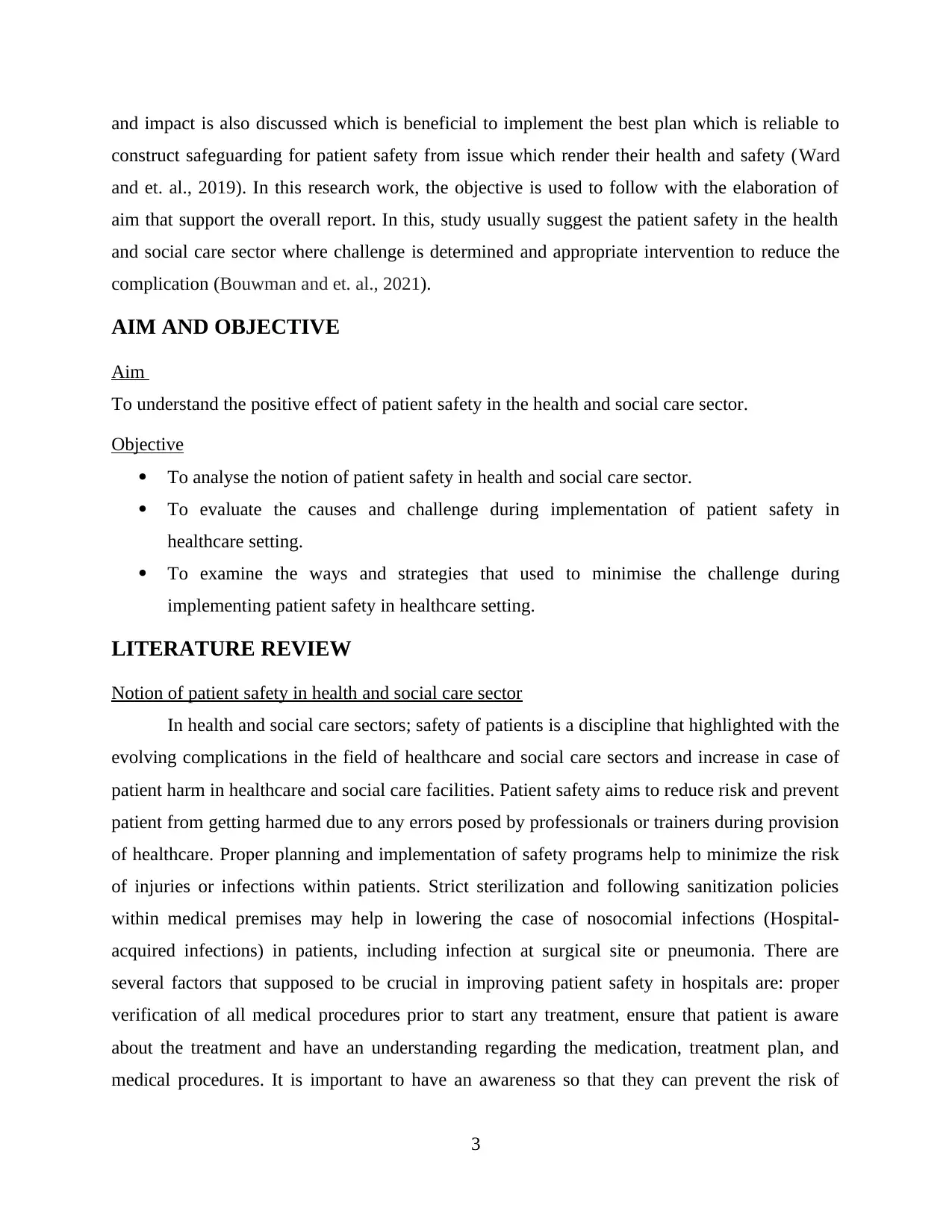
and impact is also discussed which is beneficial to implement the best plan which is reliable to
construct safeguarding for patient safety from issue which render their health and safety (Ward
and et. al., 2019). In this research work, the objective is used to follow with the elaboration of
aim that support the overall report. In this, study usually suggest the patient safety in the health
and social care sector where challenge is determined and appropriate intervention to reduce the
complication (Bouwman and et. al., 2021).
AIM AND OBJECTIVE
Aim
To understand the positive effect of patient safety in the health and social care sector.
Objective
To analyse the notion of patient safety in health and social care sector.
To evaluate the causes and challenge during implementation of patient safety in
healthcare setting.
To examine the ways and strategies that used to minimise the challenge during
implementing patient safety in healthcare setting.
LITERATURE REVIEW
Notion of patient safety in health and social care sector
In health and social care sectors; safety of patients is a discipline that highlighted with the
evolving complications in the field of healthcare and social care sectors and increase in case of
patient harm in healthcare and social care facilities. Patient safety aims to reduce risk and prevent
patient from getting harmed due to any errors posed by professionals or trainers during provision
of healthcare. Proper planning and implementation of safety programs help to minimize the risk
of injuries or infections within patients. Strict sterilization and following sanitization policies
within medical premises may help in lowering the case of nosocomial infections (Hospital-
acquired infections) in patients, including infection at surgical site or pneumonia. There are
several factors that supposed to be crucial in improving patient safety in hospitals are: proper
verification of all medical procedures prior to start any treatment, ensure that patient is aware
about the treatment and have an understanding regarding the medication, treatment plan, and
medical procedures. It is important to have an awareness so that they can prevent the risk of
3
construct safeguarding for patient safety from issue which render their health and safety (Ward
and et. al., 2019). In this research work, the objective is used to follow with the elaboration of
aim that support the overall report. In this, study usually suggest the patient safety in the health
and social care sector where challenge is determined and appropriate intervention to reduce the
complication (Bouwman and et. al., 2021).
AIM AND OBJECTIVE
Aim
To understand the positive effect of patient safety in the health and social care sector.
Objective
To analyse the notion of patient safety in health and social care sector.
To evaluate the causes and challenge during implementation of patient safety in
healthcare setting.
To examine the ways and strategies that used to minimise the challenge during
implementing patient safety in healthcare setting.
LITERATURE REVIEW
Notion of patient safety in health and social care sector
In health and social care sectors; safety of patients is a discipline that highlighted with the
evolving complications in the field of healthcare and social care sectors and increase in case of
patient harm in healthcare and social care facilities. Patient safety aims to reduce risk and prevent
patient from getting harmed due to any errors posed by professionals or trainers during provision
of healthcare. Proper planning and implementation of safety programs help to minimize the risk
of injuries or infections within patients. Strict sterilization and following sanitization policies
within medical premises may help in lowering the case of nosocomial infections (Hospital-
acquired infections) in patients, including infection at surgical site or pneumonia. There are
several factors that supposed to be crucial in improving patient safety in hospitals are: proper
verification of all medical procedures prior to start any treatment, ensure that patient is aware
about the treatment and have an understanding regarding the medication, treatment plan, and
medical procedures. It is important to have an awareness so that they can prevent the risk of
3
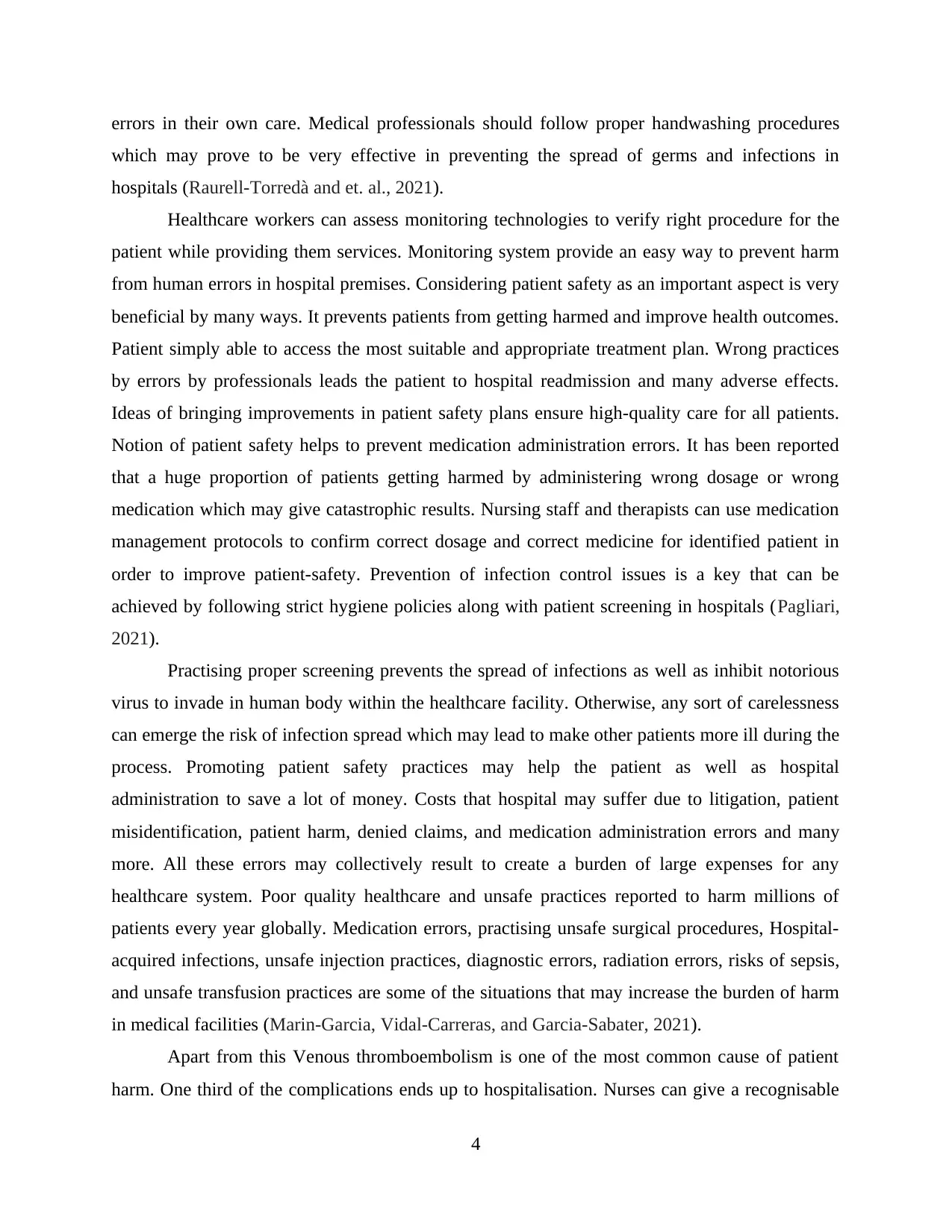
errors in their own care. Medical professionals should follow proper handwashing procedures
which may prove to be very effective in preventing the spread of germs and infections in
hospitals (Raurell-Torredà and et. al., 2021).
Healthcare workers can assess monitoring technologies to verify right procedure for the
patient while providing them services. Monitoring system provide an easy way to prevent harm
from human errors in hospital premises. Considering patient safety as an important aspect is very
beneficial by many ways. It prevents patients from getting harmed and improve health outcomes.
Patient simply able to access the most suitable and appropriate treatment plan. Wrong practices
by errors by professionals leads the patient to hospital readmission and many adverse effects.
Ideas of bringing improvements in patient safety plans ensure high-quality care for all patients.
Notion of patient safety helps to prevent medication administration errors. It has been reported
that a huge proportion of patients getting harmed by administering wrong dosage or wrong
medication which may give catastrophic results. Nursing staff and therapists can use medication
management protocols to confirm correct dosage and correct medicine for identified patient in
order to improve patient-safety. Prevention of infection control issues is a key that can be
achieved by following strict hygiene policies along with patient screening in hospitals (Pagliari,
2021).
Practising proper screening prevents the spread of infections as well as inhibit notorious
virus to invade in human body within the healthcare facility. Otherwise, any sort of carelessness
can emerge the risk of infection spread which may lead to make other patients more ill during the
process. Promoting patient safety practices may help the patient as well as hospital
administration to save a lot of money. Costs that hospital may suffer due to litigation, patient
misidentification, patient harm, denied claims, and medication administration errors and many
more. All these errors may collectively result to create a burden of large expenses for any
healthcare system. Poor quality healthcare and unsafe practices reported to harm millions of
patients every year globally. Medication errors, practising unsafe surgical procedures, Hospital-
acquired infections, unsafe injection practices, diagnostic errors, radiation errors, risks of sepsis,
and unsafe transfusion practices are some of the situations that may increase the burden of harm
in medical facilities (Marin-Garcia, Vidal-Carreras, and Garcia-Sabater, 2021).
Apart from this Venous thromboembolism is one of the most common cause of patient
harm. One third of the complications ends up to hospitalisation. Nurses can give a recognisable
4
which may prove to be very effective in preventing the spread of germs and infections in
hospitals (Raurell-Torredà and et. al., 2021).
Healthcare workers can assess monitoring technologies to verify right procedure for the
patient while providing them services. Monitoring system provide an easy way to prevent harm
from human errors in hospital premises. Considering patient safety as an important aspect is very
beneficial by many ways. It prevents patients from getting harmed and improve health outcomes.
Patient simply able to access the most suitable and appropriate treatment plan. Wrong practices
by errors by professionals leads the patient to hospital readmission and many adverse effects.
Ideas of bringing improvements in patient safety plans ensure high-quality care for all patients.
Notion of patient safety helps to prevent medication administration errors. It has been reported
that a huge proportion of patients getting harmed by administering wrong dosage or wrong
medication which may give catastrophic results. Nursing staff and therapists can use medication
management protocols to confirm correct dosage and correct medicine for identified patient in
order to improve patient-safety. Prevention of infection control issues is a key that can be
achieved by following strict hygiene policies along with patient screening in hospitals (Pagliari,
2021).
Practising proper screening prevents the spread of infections as well as inhibit notorious
virus to invade in human body within the healthcare facility. Otherwise, any sort of carelessness
can emerge the risk of infection spread which may lead to make other patients more ill during the
process. Promoting patient safety practices may help the patient as well as hospital
administration to save a lot of money. Costs that hospital may suffer due to litigation, patient
misidentification, patient harm, denied claims, and medication administration errors and many
more. All these errors may collectively result to create a burden of large expenses for any
healthcare system. Poor quality healthcare and unsafe practices reported to harm millions of
patients every year globally. Medication errors, practising unsafe surgical procedures, Hospital-
acquired infections, unsafe injection practices, diagnostic errors, radiation errors, risks of sepsis,
and unsafe transfusion practices are some of the situations that may increase the burden of harm
in medical facilities (Marin-Garcia, Vidal-Carreras, and Garcia-Sabater, 2021).
Apart from this Venous thromboembolism is one of the most common cause of patient
harm. One third of the complications ends up to hospitalisation. Nurses can give a recognisable
4
⊘ This is a preview!⊘
Do you want full access?
Subscribe today to unlock all pages.

Trusted by 1+ million students worldwide

contribution in improving patient safety by educating patients about self-care and procedures
they need to follow after getting discharge from hospital facilities. Patients need to be provided
with a complete knowledge of medication and self-care routine post-discharge helps to facilitate
a smooth recovery. In high quality and multi-speciality hospitals, nurses are seeming to be
treated as physician's partner which help to avoid errors. Nurses are believed to be the second
pair of eyes that provide support to care team and physicians. In professional office setting,
nurses play their part in process of medication reconciliation process. In which they investigate
for risks of therapeutic class duplication and drug interaction and inform physicians about
possible potential errors. Major blocks in the path of providing safety to patients are non-
compliance with medication regimen and access of improper usage of medicines (Iversen and et.
al., 2021).
Especially for patients who suffer from chronic disease and in case of elderly patients
running on ten or more medications; chances of non-compliance increases. Nurses are in direct
touch with patient and able to create a relationship with patient which is effective enough to
explain and motivate the service users to take medications in a way as they are prescribed by
physician. Effective intervention and communication with patient and/ or their family helps them
to resolve all the queries regarding the medication and routine care at home. It has been observed
that elderly age patients are at more risks of getting harmed or even died due to falls. In the
inpatient setting, nurses are trained to follow some precautions that may reduce the risks of falls
while dealing with patients. They are responsible to watch unsupervised patients, manage needs
of patients regarding turning and toileting. Nurses are responsible to educate discharge planning,
providing safety sheets and tips for senior’s patients and caregivers to access self-care. Some
guidelines can be establishing to ensure safety and manage healthcare settings appropriately in
hospitals like; it is important to design hospitals in a way that definitely compliments the safety,
restructure the hospital discharge (Vindrola-Padros and et. al., 2021).
Many hospitals can reduce the rate of re-admission by considering the procedures of
hospital discharge. To bring this effect, hospital may appoint a dedicated staff to proceed the
discharge process, who will be responsible to explain diet structure, medication regimen, and
lifestyle changes to the patients. Patient should be educating about safety usage of blood
thinners. Patient safety organisations assist healthcare providers in setting up steps that may
5
they need to follow after getting discharge from hospital facilities. Patients need to be provided
with a complete knowledge of medication and self-care routine post-discharge helps to facilitate
a smooth recovery. In high quality and multi-speciality hospitals, nurses are seeming to be
treated as physician's partner which help to avoid errors. Nurses are believed to be the second
pair of eyes that provide support to care team and physicians. In professional office setting,
nurses play their part in process of medication reconciliation process. In which they investigate
for risks of therapeutic class duplication and drug interaction and inform physicians about
possible potential errors. Major blocks in the path of providing safety to patients are non-
compliance with medication regimen and access of improper usage of medicines (Iversen and et.
al., 2021).
Especially for patients who suffer from chronic disease and in case of elderly patients
running on ten or more medications; chances of non-compliance increases. Nurses are in direct
touch with patient and able to create a relationship with patient which is effective enough to
explain and motivate the service users to take medications in a way as they are prescribed by
physician. Effective intervention and communication with patient and/ or their family helps them
to resolve all the queries regarding the medication and routine care at home. It has been observed
that elderly age patients are at more risks of getting harmed or even died due to falls. In the
inpatient setting, nurses are trained to follow some precautions that may reduce the risks of falls
while dealing with patients. They are responsible to watch unsupervised patients, manage needs
of patients regarding turning and toileting. Nurses are responsible to educate discharge planning,
providing safety sheets and tips for senior’s patients and caregivers to access self-care. Some
guidelines can be establishing to ensure safety and manage healthcare settings appropriately in
hospitals like; it is important to design hospitals in a way that definitely compliments the safety,
restructure the hospital discharge (Vindrola-Padros and et. al., 2021).
Many hospitals can reduce the rate of re-admission by considering the procedures of
hospital discharge. To bring this effect, hospital may appoint a dedicated staff to proceed the
discharge process, who will be responsible to explain diet structure, medication regimen, and
lifestyle changes to the patients. Patient should be educating about safety usage of blood
thinners. Patient safety organisations assist healthcare providers in setting up steps that may
5
Paraphrase This Document
Need a fresh take? Get an instant paraphrase of this document with our AI Paraphraser
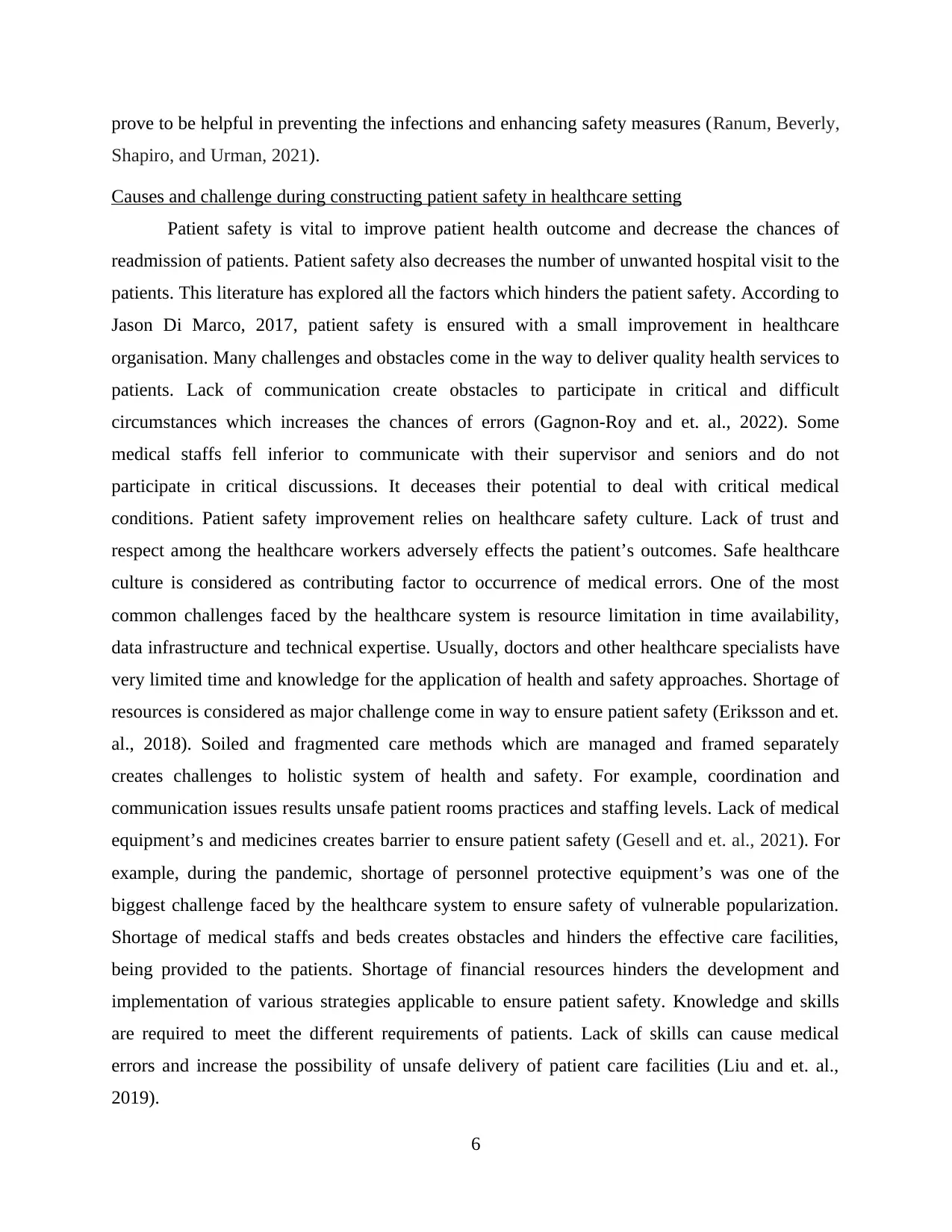
prove to be helpful in preventing the infections and enhancing safety measures (Ranum, Beverly,
Shapiro, and Urman, 2021).
Causes and challenge during constructing patient safety in healthcare setting
Patient safety is vital to improve patient health outcome and decrease the chances of
readmission of patients. Patient safety also decreases the number of unwanted hospital visit to the
patients. This literature has explored all the factors which hinders the patient safety. According to
Jason Di Marco, 2017, patient safety is ensured with a small improvement in healthcare
organisation. Many challenges and obstacles come in the way to deliver quality health services to
patients. Lack of communication create obstacles to participate in critical and difficult
circumstances which increases the chances of errors (Gagnon-Roy and et. al., 2022). Some
medical staffs fell inferior to communicate with their supervisor and seniors and do not
participate in critical discussions. It deceases their potential to deal with critical medical
conditions. Patient safety improvement relies on healthcare safety culture. Lack of trust and
respect among the healthcare workers adversely effects the patient’s outcomes. Safe healthcare
culture is considered as contributing factor to occurrence of medical errors. One of the most
common challenges faced by the healthcare system is resource limitation in time availability,
data infrastructure and technical expertise. Usually, doctors and other healthcare specialists have
very limited time and knowledge for the application of health and safety approaches. Shortage of
resources is considered as major challenge come in way to ensure patient safety (Eriksson and et.
al., 2018). Soiled and fragmented care methods which are managed and framed separately
creates challenges to holistic system of health and safety. For example, coordination and
communication issues results unsafe patient rooms practices and staffing levels. Lack of medical
equipment’s and medicines creates barrier to ensure patient safety (Gesell and et. al., 2021). For
example, during the pandemic, shortage of personnel protective equipment’s was one of the
biggest challenge faced by the healthcare system to ensure safety of vulnerable popularization.
Shortage of medical staffs and beds creates obstacles and hinders the effective care facilities,
being provided to the patients. Shortage of financial resources hinders the development and
implementation of various strategies applicable to ensure patient safety. Knowledge and skills
are required to meet the different requirements of patients. Lack of skills can cause medical
errors and increase the possibility of unsafe delivery of patient care facilities (Liu and et. al.,
2019).
6
Shapiro, and Urman, 2021).
Causes and challenge during constructing patient safety in healthcare setting
Patient safety is vital to improve patient health outcome and decrease the chances of
readmission of patients. Patient safety also decreases the number of unwanted hospital visit to the
patients. This literature has explored all the factors which hinders the patient safety. According to
Jason Di Marco, 2017, patient safety is ensured with a small improvement in healthcare
organisation. Many challenges and obstacles come in the way to deliver quality health services to
patients. Lack of communication create obstacles to participate in critical and difficult
circumstances which increases the chances of errors (Gagnon-Roy and et. al., 2022). Some
medical staffs fell inferior to communicate with their supervisor and seniors and do not
participate in critical discussions. It deceases their potential to deal with critical medical
conditions. Patient safety improvement relies on healthcare safety culture. Lack of trust and
respect among the healthcare workers adversely effects the patient’s outcomes. Safe healthcare
culture is considered as contributing factor to occurrence of medical errors. One of the most
common challenges faced by the healthcare system is resource limitation in time availability,
data infrastructure and technical expertise. Usually, doctors and other healthcare specialists have
very limited time and knowledge for the application of health and safety approaches. Shortage of
resources is considered as major challenge come in way to ensure patient safety (Eriksson and et.
al., 2018). Soiled and fragmented care methods which are managed and framed separately
creates challenges to holistic system of health and safety. For example, coordination and
communication issues results unsafe patient rooms practices and staffing levels. Lack of medical
equipment’s and medicines creates barrier to ensure patient safety (Gesell and et. al., 2021). For
example, during the pandemic, shortage of personnel protective equipment’s was one of the
biggest challenge faced by the healthcare system to ensure safety of vulnerable popularization.
Shortage of medical staffs and beds creates obstacles and hinders the effective care facilities,
being provided to the patients. Shortage of financial resources hinders the development and
implementation of various strategies applicable to ensure patient safety. Knowledge and skills
are required to meet the different requirements of patients. Lack of skills can cause medical
errors and increase the possibility of unsafe delivery of patient care facilities (Liu and et. al.,
2019).
6
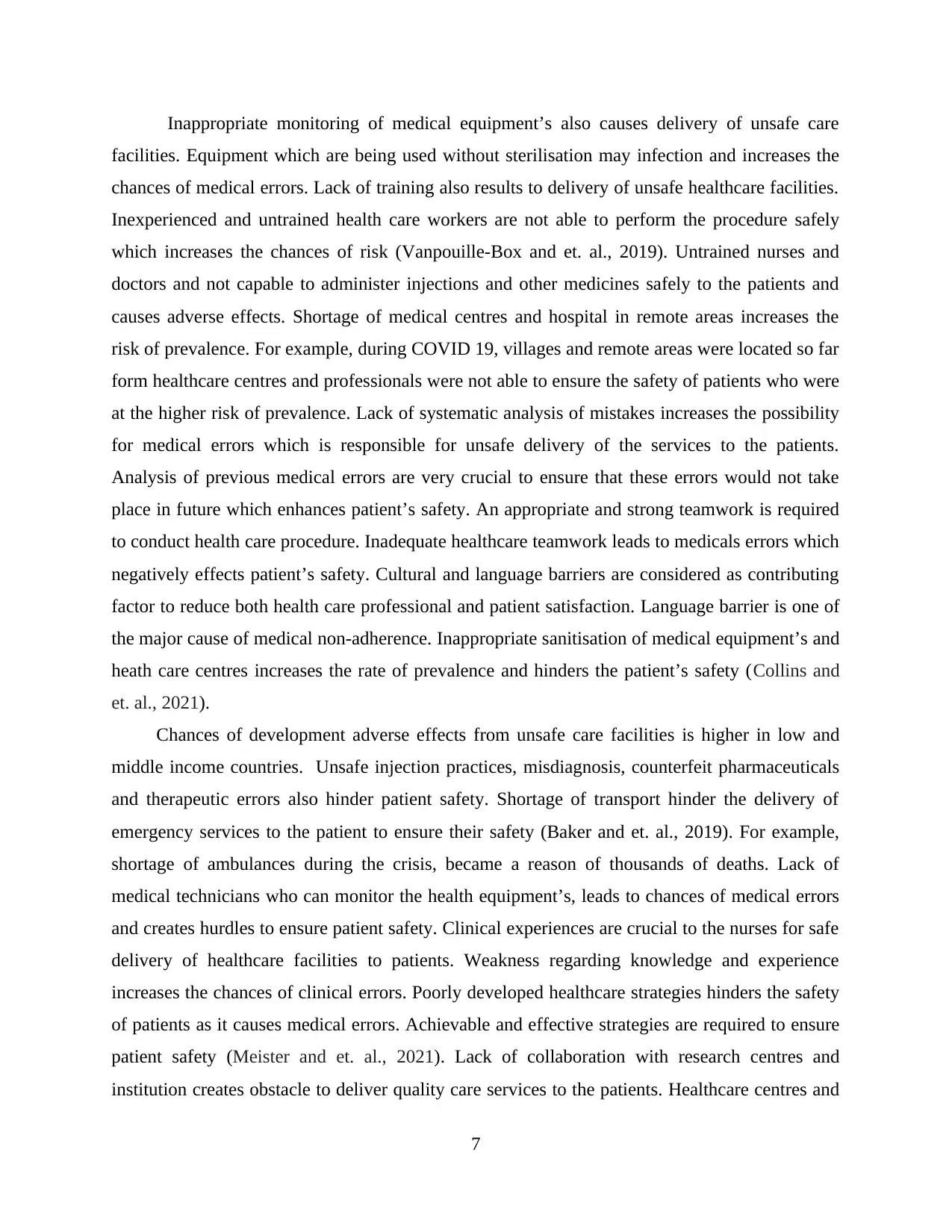
Inappropriate monitoring of medical equipment’s also causes delivery of unsafe care
facilities. Equipment which are being used without sterilisation may infection and increases the
chances of medical errors. Lack of training also results to delivery of unsafe healthcare facilities.
Inexperienced and untrained health care workers are not able to perform the procedure safely
which increases the chances of risk (Vanpouille-Box and et. al., 2019). Untrained nurses and
doctors and not capable to administer injections and other medicines safely to the patients and
causes adverse effects. Shortage of medical centres and hospital in remote areas increases the
risk of prevalence. For example, during COVID 19, villages and remote areas were located so far
form healthcare centres and professionals were not able to ensure the safety of patients who were
at the higher risk of prevalence. Lack of systematic analysis of mistakes increases the possibility
for medical errors which is responsible for unsafe delivery of the services to the patients.
Analysis of previous medical errors are very crucial to ensure that these errors would not take
place in future which enhances patient’s safety. An appropriate and strong teamwork is required
to conduct health care procedure. Inadequate healthcare teamwork leads to medicals errors which
negatively effects patient’s safety. Cultural and language barriers are considered as contributing
factor to reduce both health care professional and patient satisfaction. Language barrier is one of
the major cause of medical non-adherence. Inappropriate sanitisation of medical equipment’s and
heath care centres increases the rate of prevalence and hinders the patient’s safety (Collins and
et. al., 2021).
Chances of development adverse effects from unsafe care facilities is higher in low and
middle income countries. Unsafe injection practices, misdiagnosis, counterfeit pharmaceuticals
and therapeutic errors also hinder patient safety. Shortage of transport hinder the delivery of
emergency services to the patient to ensure their safety (Baker and et. al., 2019). For example,
shortage of ambulances during the crisis, became a reason of thousands of deaths. Lack of
medical technicians who can monitor the health equipment’s, leads to chances of medical errors
and creates hurdles to ensure patient safety. Clinical experiences are crucial to the nurses for safe
delivery of healthcare facilities to patients. Weakness regarding knowledge and experience
increases the chances of clinical errors. Poorly developed healthcare strategies hinders the safety
of patients as it causes medical errors. Achievable and effective strategies are required to ensure
patient safety (Meister and et. al., 2021). Lack of collaboration with research centres and
institution creates obstacle to deliver quality care services to the patients. Healthcare centres and
7
facilities. Equipment which are being used without sterilisation may infection and increases the
chances of medical errors. Lack of training also results to delivery of unsafe healthcare facilities.
Inexperienced and untrained health care workers are not able to perform the procedure safely
which increases the chances of risk (Vanpouille-Box and et. al., 2019). Untrained nurses and
doctors and not capable to administer injections and other medicines safely to the patients and
causes adverse effects. Shortage of medical centres and hospital in remote areas increases the
risk of prevalence. For example, during COVID 19, villages and remote areas were located so far
form healthcare centres and professionals were not able to ensure the safety of patients who were
at the higher risk of prevalence. Lack of systematic analysis of mistakes increases the possibility
for medical errors which is responsible for unsafe delivery of the services to the patients.
Analysis of previous medical errors are very crucial to ensure that these errors would not take
place in future which enhances patient’s safety. An appropriate and strong teamwork is required
to conduct health care procedure. Inadequate healthcare teamwork leads to medicals errors which
negatively effects patient’s safety. Cultural and language barriers are considered as contributing
factor to reduce both health care professional and patient satisfaction. Language barrier is one of
the major cause of medical non-adherence. Inappropriate sanitisation of medical equipment’s and
heath care centres increases the rate of prevalence and hinders the patient’s safety (Collins and
et. al., 2021).
Chances of development adverse effects from unsafe care facilities is higher in low and
middle income countries. Unsafe injection practices, misdiagnosis, counterfeit pharmaceuticals
and therapeutic errors also hinder patient safety. Shortage of transport hinder the delivery of
emergency services to the patient to ensure their safety (Baker and et. al., 2019). For example,
shortage of ambulances during the crisis, became a reason of thousands of deaths. Lack of
medical technicians who can monitor the health equipment’s, leads to chances of medical errors
and creates hurdles to ensure patient safety. Clinical experiences are crucial to the nurses for safe
delivery of healthcare facilities to patients. Weakness regarding knowledge and experience
increases the chances of clinical errors. Poorly developed healthcare strategies hinders the safety
of patients as it causes medical errors. Achievable and effective strategies are required to ensure
patient safety (Meister and et. al., 2021). Lack of collaboration with research centres and
institution creates obstacle to deliver quality care services to the patients. Healthcare centres and
7
⊘ This is a preview!⊘
Do you want full access?
Subscribe today to unlock all pages.

Trusted by 1+ million students worldwide
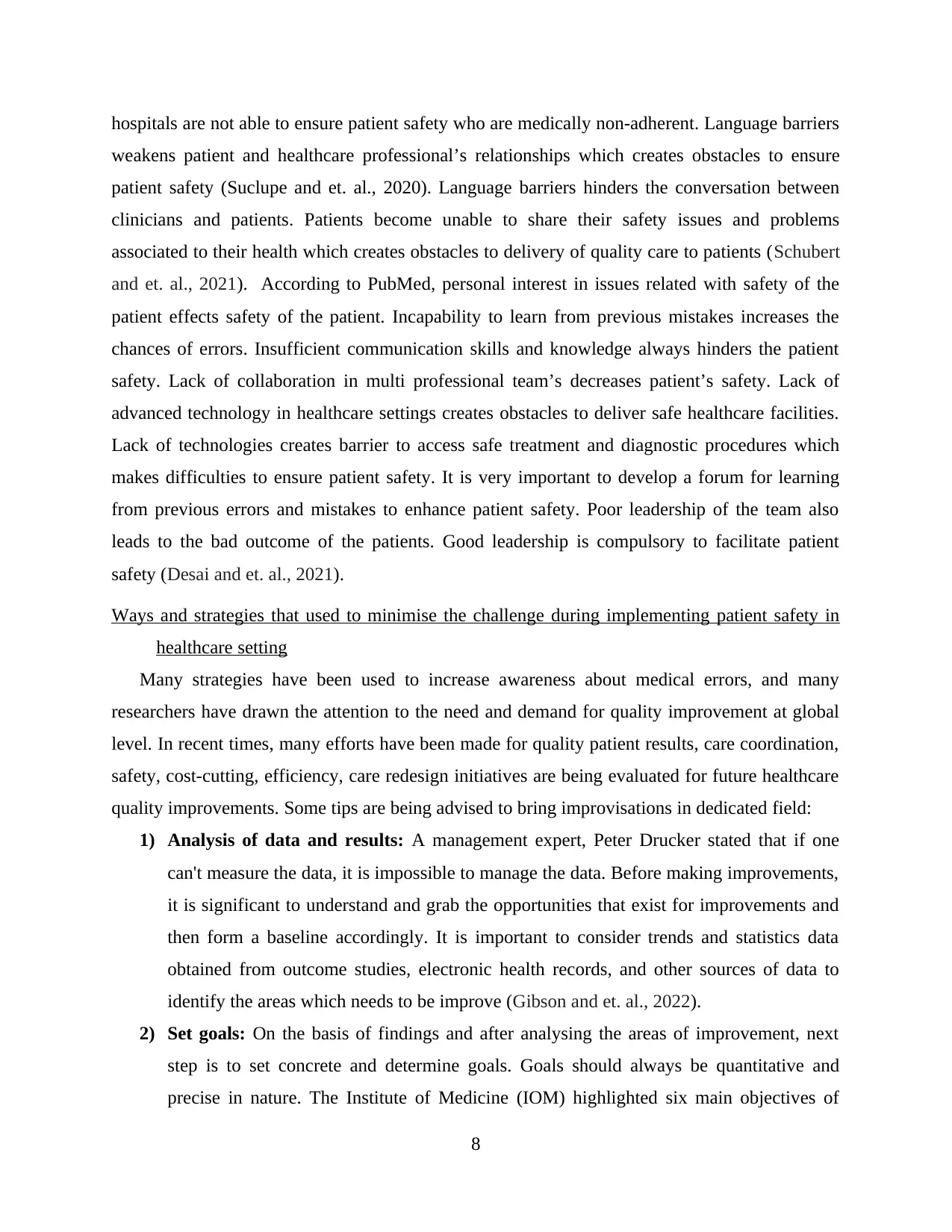
hospitals are not able to ensure patient safety who are medically non-adherent. Language barriers
weakens patient and healthcare professional’s relationships which creates obstacles to ensure
patient safety (Suclupe and et. al., 2020). Language barriers hinders the conversation between
clinicians and patients. Patients become unable to share their safety issues and problems
associated to their health which creates obstacles to delivery of quality care to patients (Schubert
and et. al., 2021). According to PubMed, personal interest in issues related with safety of the
patient effects safety of the patient. Incapability to learn from previous mistakes increases the
chances of errors. Insufficient communication skills and knowledge always hinders the patient
safety. Lack of collaboration in multi professional team’s decreases patient’s safety. Lack of
advanced technology in healthcare settings creates obstacles to deliver safe healthcare facilities.
Lack of technologies creates barrier to access safe treatment and diagnostic procedures which
makes difficulties to ensure patient safety. It is very important to develop a forum for learning
from previous errors and mistakes to enhance patient safety. Poor leadership of the team also
leads to the bad outcome of the patients. Good leadership is compulsory to facilitate patient
safety (Desai and et. al., 2021).
Ways and strategies that used to minimise the challenge during implementing patient safety in
healthcare setting
Many strategies have been used to increase awareness about medical errors, and many
researchers have drawn the attention to the need and demand for quality improvement at global
level. In recent times, many efforts have been made for quality patient results, care coordination,
safety, cost-cutting, efficiency, care redesign initiatives are being evaluated for future healthcare
quality improvements. Some tips are being advised to bring improvisations in dedicated field:
1) Analysis of data and results: A management expert, Peter Drucker stated that if one
can't measure the data, it is impossible to manage the data. Before making improvements,
it is significant to understand and grab the opportunities that exist for improvements and
then form a baseline accordingly. It is important to consider trends and statistics data
obtained from outcome studies, electronic health records, and other sources of data to
identify the areas which needs to be improve (Gibson and et. al., 2022).
2) Set goals: On the basis of findings and after analysing the areas of improvement, next
step is to set concrete and determine goals. Goals should always be quantitative and
precise in nature. The Institute of Medicine (IOM) highlighted six main objectives of
8
weakens patient and healthcare professional’s relationships which creates obstacles to ensure
patient safety (Suclupe and et. al., 2020). Language barriers hinders the conversation between
clinicians and patients. Patients become unable to share their safety issues and problems
associated to their health which creates obstacles to delivery of quality care to patients (Schubert
and et. al., 2021). According to PubMed, personal interest in issues related with safety of the
patient effects safety of the patient. Incapability to learn from previous mistakes increases the
chances of errors. Insufficient communication skills and knowledge always hinders the patient
safety. Lack of collaboration in multi professional team’s decreases patient’s safety. Lack of
advanced technology in healthcare settings creates obstacles to deliver safe healthcare facilities.
Lack of technologies creates barrier to access safe treatment and diagnostic procedures which
makes difficulties to ensure patient safety. It is very important to develop a forum for learning
from previous errors and mistakes to enhance patient safety. Poor leadership of the team also
leads to the bad outcome of the patients. Good leadership is compulsory to facilitate patient
safety (Desai and et. al., 2021).
Ways and strategies that used to minimise the challenge during implementing patient safety in
healthcare setting
Many strategies have been used to increase awareness about medical errors, and many
researchers have drawn the attention to the need and demand for quality improvement at global
level. In recent times, many efforts have been made for quality patient results, care coordination,
safety, cost-cutting, efficiency, care redesign initiatives are being evaluated for future healthcare
quality improvements. Some tips are being advised to bring improvisations in dedicated field:
1) Analysis of data and results: A management expert, Peter Drucker stated that if one
can't measure the data, it is impossible to manage the data. Before making improvements,
it is significant to understand and grab the opportunities that exist for improvements and
then form a baseline accordingly. It is important to consider trends and statistics data
obtained from outcome studies, electronic health records, and other sources of data to
identify the areas which needs to be improve (Gibson and et. al., 2022).
2) Set goals: On the basis of findings and after analysing the areas of improvement, next
step is to set concrete and determine goals. Goals should always be quantitative and
precise in nature. The Institute of Medicine (IOM) highlighted six main objectives of
8
Paraphrase This Document
Need a fresh take? Get an instant paraphrase of this document with our AI Paraphraser
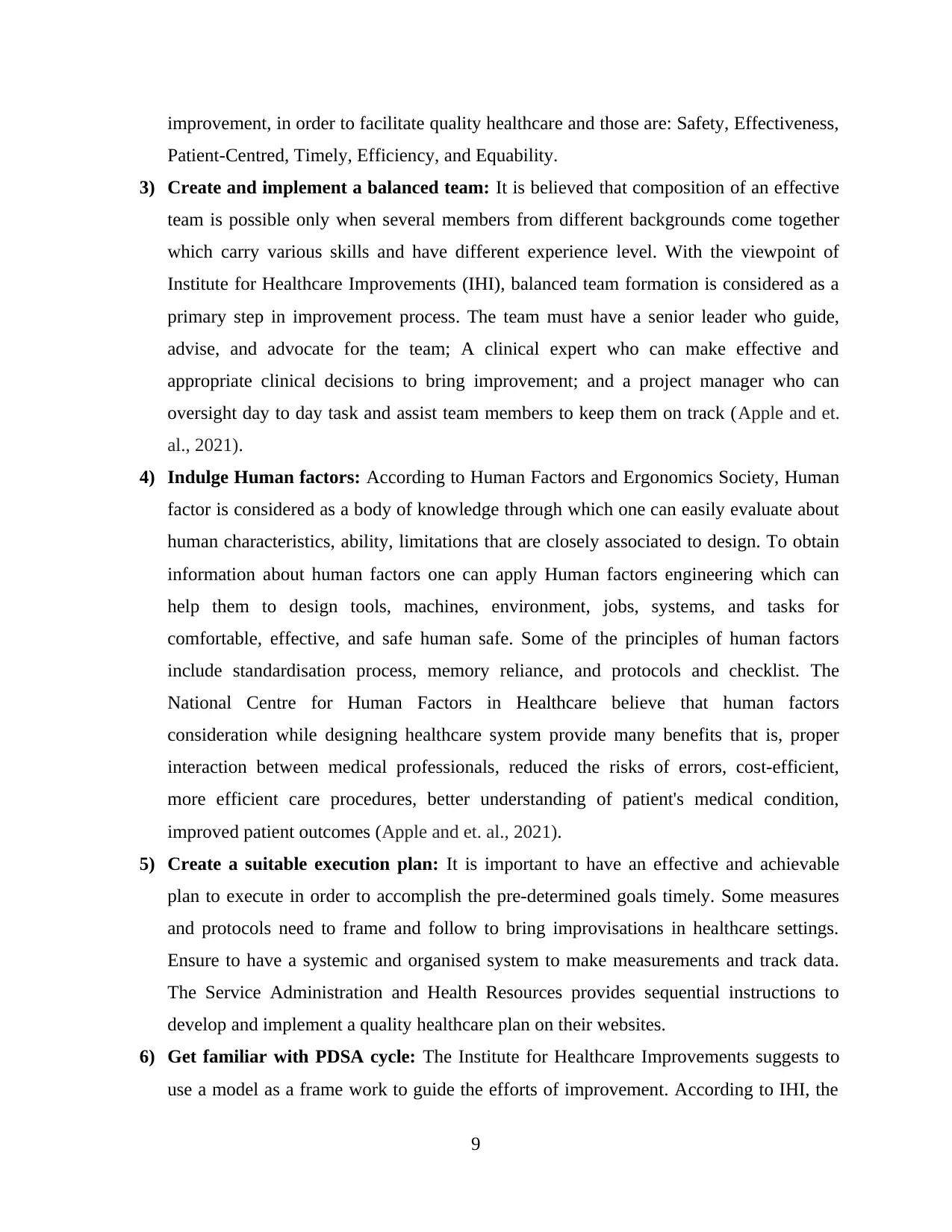
improvement, in order to facilitate quality healthcare and those are: Safety, Effectiveness,
Patient-Centred, Timely, Efficiency, and Equability.
3) Create and implement a balanced team: It is believed that composition of an effective
team is possible only when several members from different backgrounds come together
which carry various skills and have different experience level. With the viewpoint of
Institute for Healthcare Improvements (IHI), balanced team formation is considered as a
primary step in improvement process. The team must have a senior leader who guide,
advise, and advocate for the team; A clinical expert who can make effective and
appropriate clinical decisions to bring improvement; and a project manager who can
oversight day to day task and assist team members to keep them on track (Apple and et.
al., 2021).
4) Indulge Human factors: According to Human Factors and Ergonomics Society, Human
factor is considered as a body of knowledge through which one can easily evaluate about
human characteristics, ability, limitations that are closely associated to design. To obtain
information about human factors one can apply Human factors engineering which can
help them to design tools, machines, environment, jobs, systems, and tasks for
comfortable, effective, and safe human safe. Some of the principles of human factors
include standardisation process, memory reliance, and protocols and checklist. The
National Centre for Human Factors in Healthcare believe that human factors
consideration while designing healthcare system provide many benefits that is, proper
interaction between medical professionals, reduced the risks of errors, cost-efficient,
more efficient care procedures, better understanding of patient's medical condition,
improved patient outcomes (Apple and et. al., 2021).
5) Create a suitable execution plan: It is important to have an effective and achievable
plan to execute in order to accomplish the pre-determined goals timely. Some measures
and protocols need to frame and follow to bring improvisations in healthcare settings.
Ensure to have a systemic and organised system to make measurements and track data.
The Service Administration and Health Resources provides sequential instructions to
develop and implement a quality healthcare plan on their websites.
6) Get familiar with PDSA cycle: The Institute for Healthcare Improvements suggests to
use a model as a frame work to guide the efforts of improvement. According to IHI, the
9
Patient-Centred, Timely, Efficiency, and Equability.
3) Create and implement a balanced team: It is believed that composition of an effective
team is possible only when several members from different backgrounds come together
which carry various skills and have different experience level. With the viewpoint of
Institute for Healthcare Improvements (IHI), balanced team formation is considered as a
primary step in improvement process. The team must have a senior leader who guide,
advise, and advocate for the team; A clinical expert who can make effective and
appropriate clinical decisions to bring improvement; and a project manager who can
oversight day to day task and assist team members to keep them on track (Apple and et.
al., 2021).
4) Indulge Human factors: According to Human Factors and Ergonomics Society, Human
factor is considered as a body of knowledge through which one can easily evaluate about
human characteristics, ability, limitations that are closely associated to design. To obtain
information about human factors one can apply Human factors engineering which can
help them to design tools, machines, environment, jobs, systems, and tasks for
comfortable, effective, and safe human safe. Some of the principles of human factors
include standardisation process, memory reliance, and protocols and checklist. The
National Centre for Human Factors in Healthcare believe that human factors
consideration while designing healthcare system provide many benefits that is, proper
interaction between medical professionals, reduced the risks of errors, cost-efficient,
more efficient care procedures, better understanding of patient's medical condition,
improved patient outcomes (Apple and et. al., 2021).
5) Create a suitable execution plan: It is important to have an effective and achievable
plan to execute in order to accomplish the pre-determined goals timely. Some measures
and protocols need to frame and follow to bring improvisations in healthcare settings.
Ensure to have a systemic and organised system to make measurements and track data.
The Service Administration and Health Resources provides sequential instructions to
develop and implement a quality healthcare plan on their websites.
6) Get familiar with PDSA cycle: The Institute for Healthcare Improvements suggests to
use a model as a frame work to guide the efforts of improvement. According to IHI, the
9
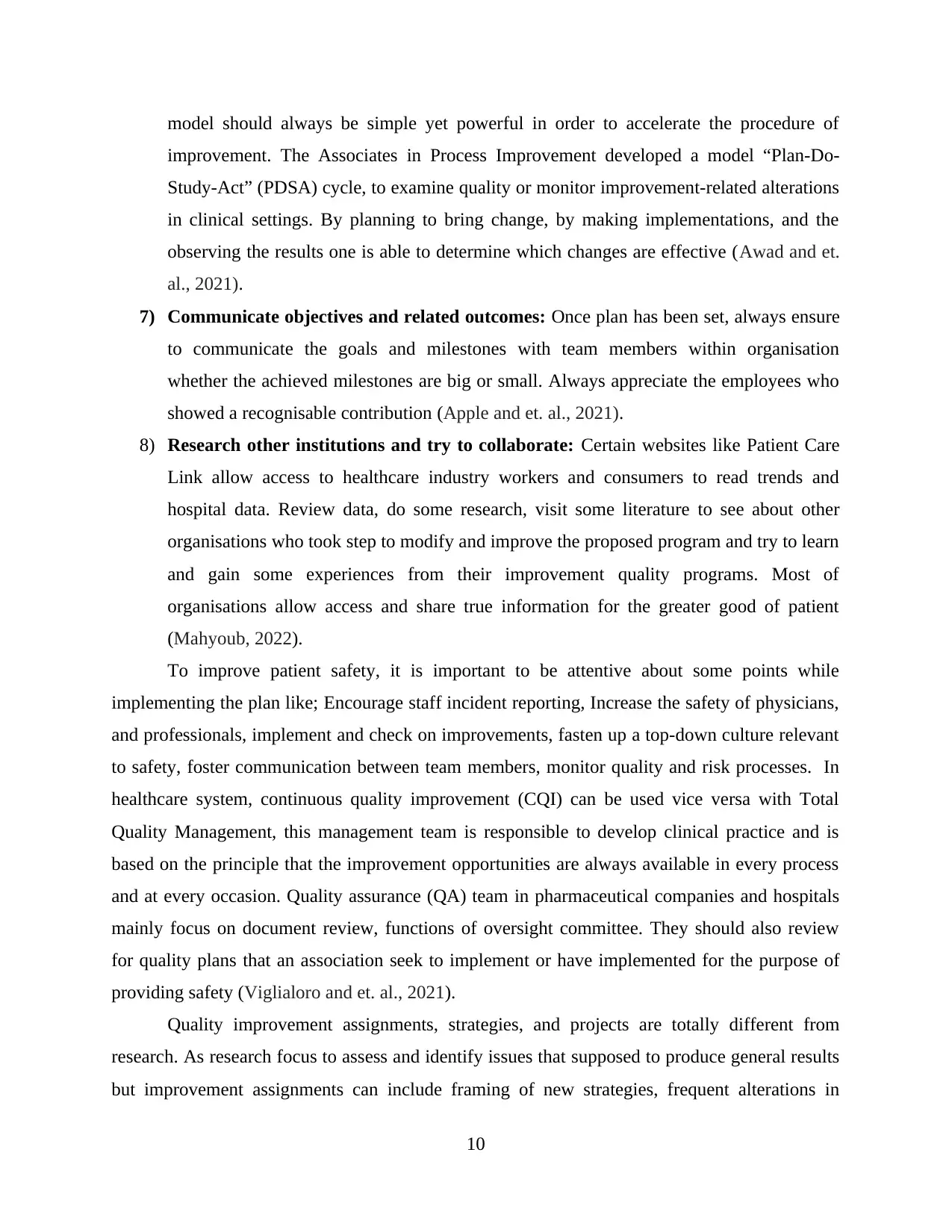
model should always be simple yet powerful in order to accelerate the procedure of
improvement. The Associates in Process Improvement developed a model “Plan-Do-
Study-Act” (PDSA) cycle, to examine quality or monitor improvement-related alterations
in clinical settings. By planning to bring change, by making implementations, and the
observing the results one is able to determine which changes are effective (Awad and et.
al., 2021).
7) Communicate objectives and related outcomes: Once plan has been set, always ensure
to communicate the goals and milestones with team members within organisation
whether the achieved milestones are big or small. Always appreciate the employees who
showed a recognisable contribution (Apple and et. al., 2021).
8) Research other institutions and try to collaborate: Certain websites like Patient Care
Link allow access to healthcare industry workers and consumers to read trends and
hospital data. Review data, do some research, visit some literature to see about other
organisations who took step to modify and improve the proposed program and try to learn
and gain some experiences from their improvement quality programs. Most of
organisations allow access and share true information for the greater good of patient
(Mahyoub, 2022).
To improve patient safety, it is important to be attentive about some points while
implementing the plan like; Encourage staff incident reporting, Increase the safety of physicians,
and professionals, implement and check on improvements, fasten up a top-down culture relevant
to safety, foster communication between team members, monitor quality and risk processes. In
healthcare system, continuous quality improvement (CQI) can be used vice versa with Total
Quality Management, this management team is responsible to develop clinical practice and is
based on the principle that the improvement opportunities are always available in every process
and at every occasion. Quality assurance (QA) team in pharmaceutical companies and hospitals
mainly focus on document review, functions of oversight committee. They should also review
for quality plans that an association seek to implement or have implemented for the purpose of
providing safety (Viglialoro and et. al., 2021).
Quality improvement assignments, strategies, and projects are totally different from
research. As research focus to assess and identify issues that supposed to produce general results
but improvement assignments can include framing of new strategies, frequent alterations in
10
improvement. The Associates in Process Improvement developed a model “Plan-Do-
Study-Act” (PDSA) cycle, to examine quality or monitor improvement-related alterations
in clinical settings. By planning to bring change, by making implementations, and the
observing the results one is able to determine which changes are effective (Awad and et.
al., 2021).
7) Communicate objectives and related outcomes: Once plan has been set, always ensure
to communicate the goals and milestones with team members within organisation
whether the achieved milestones are big or small. Always appreciate the employees who
showed a recognisable contribution (Apple and et. al., 2021).
8) Research other institutions and try to collaborate: Certain websites like Patient Care
Link allow access to healthcare industry workers and consumers to read trends and
hospital data. Review data, do some research, visit some literature to see about other
organisations who took step to modify and improve the proposed program and try to learn
and gain some experiences from their improvement quality programs. Most of
organisations allow access and share true information for the greater good of patient
(Mahyoub, 2022).
To improve patient safety, it is important to be attentive about some points while
implementing the plan like; Encourage staff incident reporting, Increase the safety of physicians,
and professionals, implement and check on improvements, fasten up a top-down culture relevant
to safety, foster communication between team members, monitor quality and risk processes. In
healthcare system, continuous quality improvement (CQI) can be used vice versa with Total
Quality Management, this management team is responsible to develop clinical practice and is
based on the principle that the improvement opportunities are always available in every process
and at every occasion. Quality assurance (QA) team in pharmaceutical companies and hospitals
mainly focus on document review, functions of oversight committee. They should also review
for quality plans that an association seek to implement or have implemented for the purpose of
providing safety (Viglialoro and et. al., 2021).
Quality improvement assignments, strategies, and projects are totally different from
research. As research focus to assess and identify issues that supposed to produce general results
but improvement assignments can include framing of new strategies, frequent alterations in
10
⊘ This is a preview!⊘
Do you want full access?
Subscribe today to unlock all pages.

Trusted by 1+ million students worldwide
1 out of 26
Related Documents
Your All-in-One AI-Powered Toolkit for Academic Success.
+13062052269
info@desklib.com
Available 24*7 on WhatsApp / Email
![[object Object]](/_next/static/media/star-bottom.7253800d.svg)
Unlock your academic potential
Copyright © 2020–2025 A2Z Services. All Rights Reserved. Developed and managed by ZUCOL.





